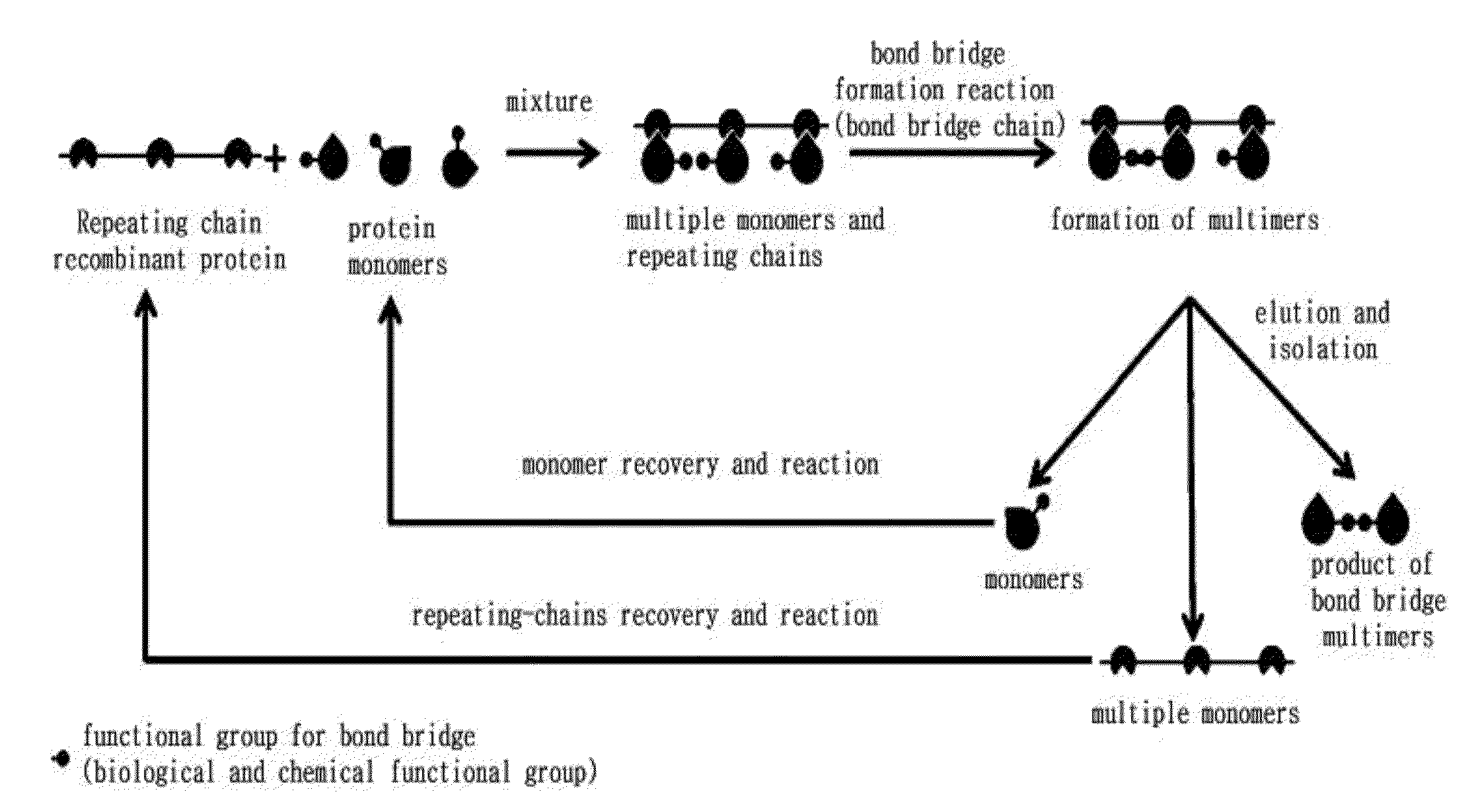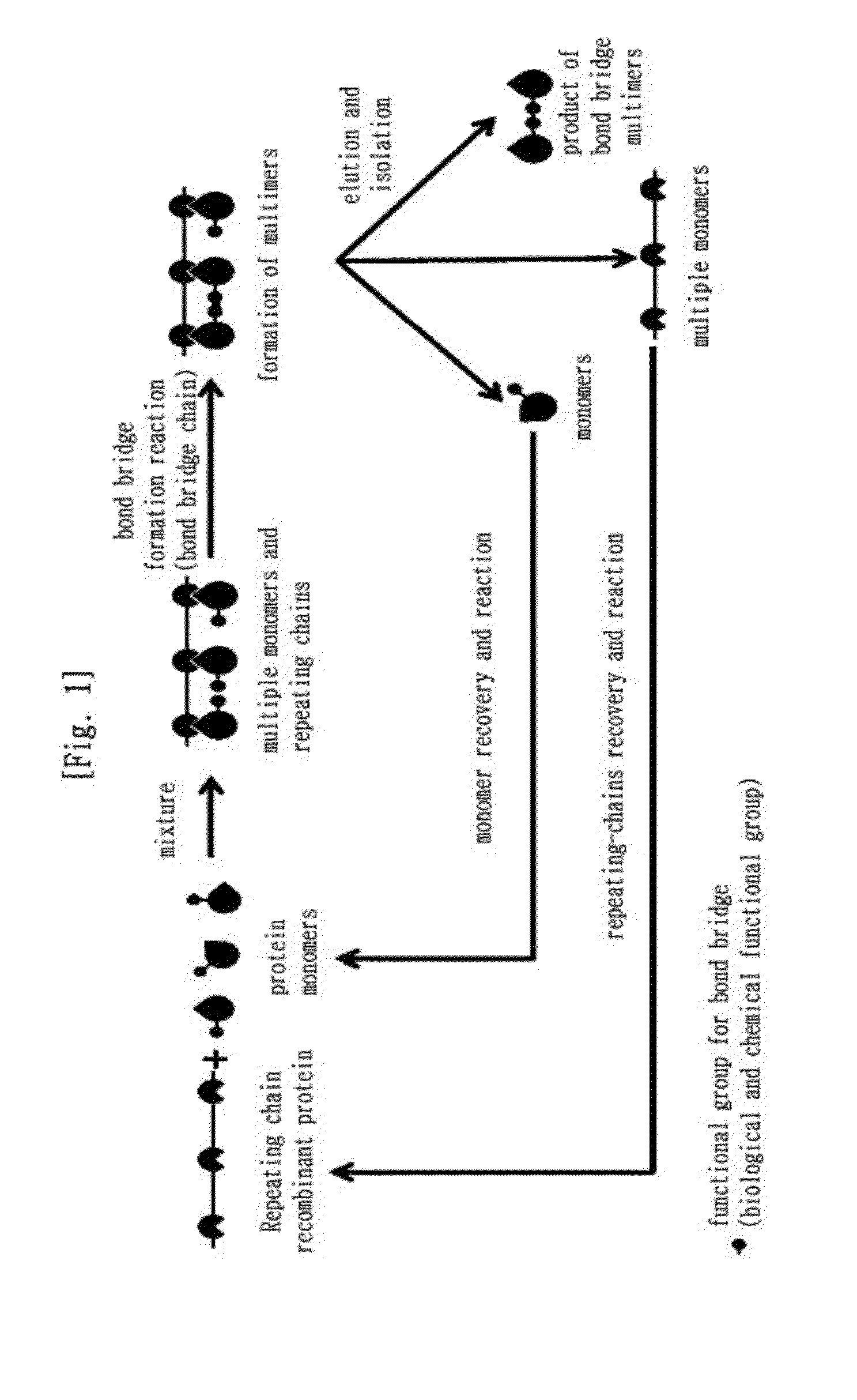Method for manufacturing dimers and multimers by increasing the production of bond bridges in a complex of multiple monomers and repeating chains of an adherend of a type specifically adhering to monomers
a technology of bond bridges and monomers, which is applied in the direction of peptides, drug compositions, peptides/protein ingredients, etc., can solve the problems of low yield of dimers created during the refolding process, and inability to improve so as to achieve high antigen binding strength, increase the yield of dimers, and improve the effect of cytotoxicity
- Summary
- Abstract
- Description
- Claims
- Application Information
AI Technical Summary
Benefits of technology
Problems solved by technology
Method used
Image
Examples
example 1
Preparation of Repeat Chains Construct of Fab Binding Domain from Streptococcal Protein G
[0109]The inventors obtained domain III of protein G from Korean Collection for Type Cultures (KCTC) and performed PCR cloning with P1[5′-GGGCA TATGC ATCAC CATCA CCATC ACACC GGTAC ACCAG CCGTG ACAA-3′(SEQ ID No: 1)] and P2[5′-CCCGA ATTCT TATCC GGACC CGCCT CCACC TTCAG TTACC GTAAA-3′(SEQ ID No:2)] primers from chromosomal DNA of Streptococcus. The PCR products (243 bp) were cut with NdeI and EcoRI, and were cloned into vector pCW1 which was cut with the same. The encoding sequence of the domain III was confirmed by dideoxy-DNA sequencing. G4S linker for each domain III was added as spacer and thus, pTR1 was obtained. The plasmid pTR1 was cut again with NdeI and BspEI and 225 by fragment encoding domain III and one of G4S was ligated to the large fragment of identical pTR1 plasmid cut with NdeI and AgeI, thus pTR2 encoding the two time Tandem Repeat of domain III was obtained. The plasmid pTR2 was c...
example 2
Preparation of B3(Fab)-ext-PE38 and [B3(Fab)-ext-PE38] 2
[0112]Based on the existing method, the inventors performed over-expression, preparation and refolding of inclusion body of B3(Fd)-ext-PE38 and H6-B3(L) (J. H. Park, et al., Mol Cells 12 (2001) 398-402). The refolded proteins were purified with Q-sepharose FF, Hitrap protein G HP, and Hiload Superdex-200 pg(26 / 60)(Amersham Bioscience, Sweden) chromatography.
[0113]More specifically, B3(Fab)-ext-PE38 was prepared by inter-chain disulphide bond between B3(Fd)-ext-PE38 and H6-B3(L). The two cystein residues related to inter-chain disulphide bond locate one on CH1 domain of B3(Fd)-ext-PE38 and other on CL domain of H6-B3(L). Also, during the folding process, [B3(Fab)-ext-PE38]2 was produced by inter-monomeric disulphide bond between two of cystein residues located on the ext position of B3(Fab)-ext-PE38 monomer. After performing size-exclusion chromatography, the purities of B3(Fab)-ext-PE38 and [B3(Fab)-ext-PE38]2 were measured by ...
example 3
Binding of B3(Fab)-ext-PE38 Monomers with Repeat Chains Construct from Protein G Domain III
[0114]For the binding reaction between purified repeat chain construct of protein G domain III and B3(Fab)-ext-PE38, the inventors mixed B3(Fab)-ext-PE38 (715 μg) and TR proteins (28 μg each), incubated at 4° C. over-night, and then incubated at 37° C. for 1 hr. The reacting mixture was separated by size-exclusion chromatography (Superdex-200™ HR). The elusion profile of the protein complex was compared to those of B3(Fab)-ext-PE38 only (Kav=0.33) or [B3(Fab)-ext-PE38]2 only (Kav=0.20) as controls. The Kav value of the eluted protein peak was calculated with [Formula 1].
Kav=(Ve-Vo)(Vt-Vo)[Formular1]
[0115]wherein Ve is elution volume of the peak, Vo is void volume of the column, which is the elution volume of blue dextran 2000; and Vt is bed volume of superdex-200 column.
[0116]B3(Fab)-ext-PE38(Kav=0.22) bound to TR3 gave similar elution volume to that of [B3(Fab)-ext-PE38]2. Other complexes had...
PUM
| Property | Measurement | Unit |
|---|---|---|
| Fraction | aaaaa | aaaaa |
| Fraction | aaaaa | aaaaa |
| Fraction | aaaaa | aaaaa |
Abstract
Description
Claims
Application Information
 Login to View More
Login to View More - R&D
- Intellectual Property
- Life Sciences
- Materials
- Tech Scout
- Unparalleled Data Quality
- Higher Quality Content
- 60% Fewer Hallucinations
Browse by: Latest US Patents, China's latest patents, Technical Efficacy Thesaurus, Application Domain, Technology Topic, Popular Technical Reports.
© 2025 PatSnap. All rights reserved.Legal|Privacy policy|Modern Slavery Act Transparency Statement|Sitemap|About US| Contact US: help@patsnap.com



